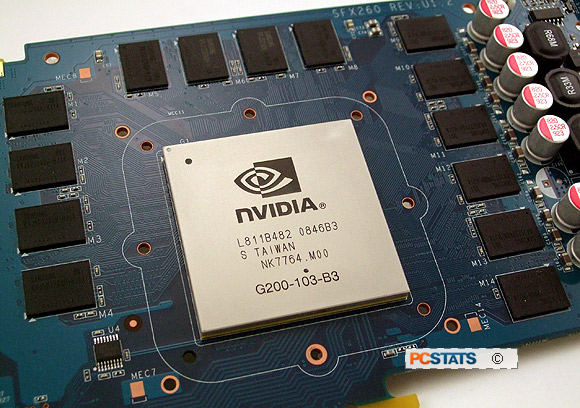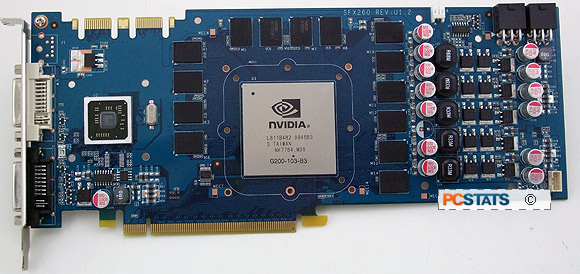
The
Sparkle GTX260 Core 216 videocard opts for nVidia's default core and
memory clock speeds, rather than pre-overclocking anything at the factory. Thus
the 55nm Geforce GTX260 GPU runs at 576MHz, the 896MB of GDDR3 memory
at 999MHz and the 216 shader processors at 1242MHz. That translates
into roughly 715 GFLOPS of processing power, nice.
To understand
where all this power comes from, we need to take a look at the nVidia GeForce GTX260
GPU - a massive monolith of an IC sheathed behind its heatspreader. Code
named 'GT200', this graphics processor is actually the second revision nVidia
has made to its new next-generation graphics processors.
The nVidia GT200 GPU chip is designed with 240
total shader processors. Each one is a tiny processor
that can compute either pixel or vertex mathematical operations. The processors are designed to
operate on graphical information simultaneously, with each shader processor is operating on a single pixel
per cycle.
These shader processors are
broken up into clusters of 24, called Texture/Processor Clusters. In
addition to the shader processors, the clusters also include a
texturing array and a geometry controller. While the high end nVidia Gefore GTX 280 graphics card has
all 10 of the GT200's TPCs enabled, the original Geforce GTX 260 had only 8 of
the 10 TPCs enabled, the remaining two are either disabled or had defects that
caused them to fail in nVidia's quality assurance testing.
The
Sparkle GTX260 Core 216 videocard that PCSTATS is tested today actually has
an additional TPC enabled, so there are 9 clusters of 24 shader processors, for
a total of 216 shader processors. This translates into a bit of extra shader
muscle and texturing savvy. The
GT200 GPU is oriented around shader processing and calculation, designed
for games that utilize intense special effects like high dynamic range lighting,
geometry distortion and dynamic reflections.

In addition to the increased
shader cores, nVidia has also managed to get the GT200 GPU's 1.4
billion transistors shrunk down to a 55nm process. While the original
65nm GT200 die was a massive 576mm2, the die-shrink brings the
overall die size down to 487mm2. Shrinking the overall size of
the chip influences power consumption, heat output and of course price.
